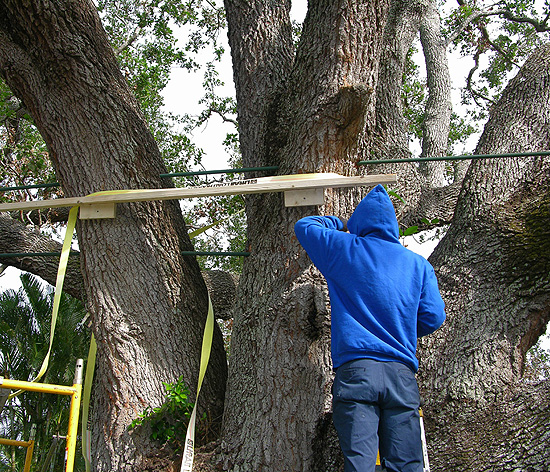
Hurricane Tree and Palm Restoration

The aftermath of a Hurricane always seems like a total disaster. Damaged buildings, property, and landscape usually appear to be ready for the bulldozer and giant tub grinder. But when a more comprehensive site assessment of the landscape has been done, many landscape trees, shrubs, and palms are not only salvageable but great candidates for raising and recovery.
When assessing a fallen tree, first check the main trunk. If it is not fractured, bent, has stress cracks, or large amounts of the bark have not been ripped off then check the root system. A general rule that I use is the “50 % rule”. If 50 % or more of the root system is relatively undamaged, that is if still attached to the trunk and still firmly rooted into the ground, then inspect the scaffold branches. The scaffold branches are the main structural branches that come directly out of the trunk and hold the weight of the rest of the canopy. If the scaffold branches are in good condition and have not split or cracked off from the main trunk, then the tree is probably a good candidate for restanding.
Before raising the fallen tree, I recommend only cutting off broken branches and not trimming the entire tree while it is down. After raising the tree, let it recover before further pruning. Branches that are on top of structures or utilities should of course be removed. Be very careful working around utilities.
The root system is a much neglected area of trees. Don’t just pull the tree upright and stake it. Before the tree is moved, dig a substantial amount of soil from underneath the trunk and root ball so that when the tree is upright, the top of the root ball is even with the ground once more. When the tree has been raised, leave it connected to the equipment while the soil that just had been removed is placed back into the hole. Do not use different soil! Don’t worry about fertilization. At this point it is a waste of time and money. The most critical issue is to wash the soil into and underneath the trunk and root ball so that no air pockets are left. If there is no water at this time, stake the tree but make sure you come back and finish washing in the soil as soon as possible! When air pockets are left within the root zone, the roots will never penetrate that area leaving the tree unstable and vulnerable to windthrow once again. I have seen large trees successfully replanted only to have large branches begin to die-off several months later. After washing in more soil (by using steel bars to penetrate the soil to find the holes) the trees eventually recovered.
The type of equipment that should be used to raise a fallen tree is of course dependant upon the size, dimensions, and weight of the tree. Location of the fallen tree for equipment access is also critical. If you are using a crane or tow truck, is the area free of power lines? What about underground utilities? Large equipment is very heavy; can the ground support the weight? Is the equipment operator/owner insured and licensed? Smaller trees can be raised by hand with various types of equipment such as chain falls that are motorized or hand operated. I have had great success using large tow trucks to raise 60’ tall Bald Cypress trees, very large Ficus trees, palms, and other plant material sometimes from distances up to 200’ away from the truck.
The rigging that is used to attach the cable(s) from the equipment to the tree is something that requires some thought and much expertise. Great pressure is exerted against the wood and bark where the straps are attached to the branches or the trunk. More points of attachment mean less stress to the tree. Sometimes pressure damage does not show up in large trees for several years when whole branches begin to die-off. Only use tree straps. Do not use chains or cables to directly attach to the tree.
Regular and adequate watering is very important to the survival of newly planted trees, especially palms. Remember how deep the roots of the tree were before you raised it? You need to get the water to penetrate to that area and a bit below for the roots to recover and thrive.
There are a few more points that need to be considered with this process of tree recovery. Use professionals to work on your trees. Make sure the contractors are licensed, insured and experienced. Every tree and palm species is different. The thickness of the bark is different and the density of the wood is different which causes different reactions to the stress of being pulled up. I recommend always using a tree company that has an ISA Certified Arborist on staff.
Finally, be aware of the trees codes of the municipality where your property is located. Make sure you photograph the fallen tree before pruning. A written report from a Certified Arborist may be required and prior documented notification to the municipality is prudent before any work is done.
Jeff Shimonski
ISA Certified Municipal Arborist FL-1052AM
June 1, 2006





 About Hurricane & Typhoon Tree Recovery
About Hurricane & Typhoon Tree Recovery Ficus Species & Hurricane Horticulture
Ficus Species & Hurricane Horticulture Hurricane Tree and Palm Restoration
Hurricane Tree and Palm Restoration Saving Large Fallen Trees after Hurricane Andrew
Saving Large Fallen Trees after Hurricane Andrew